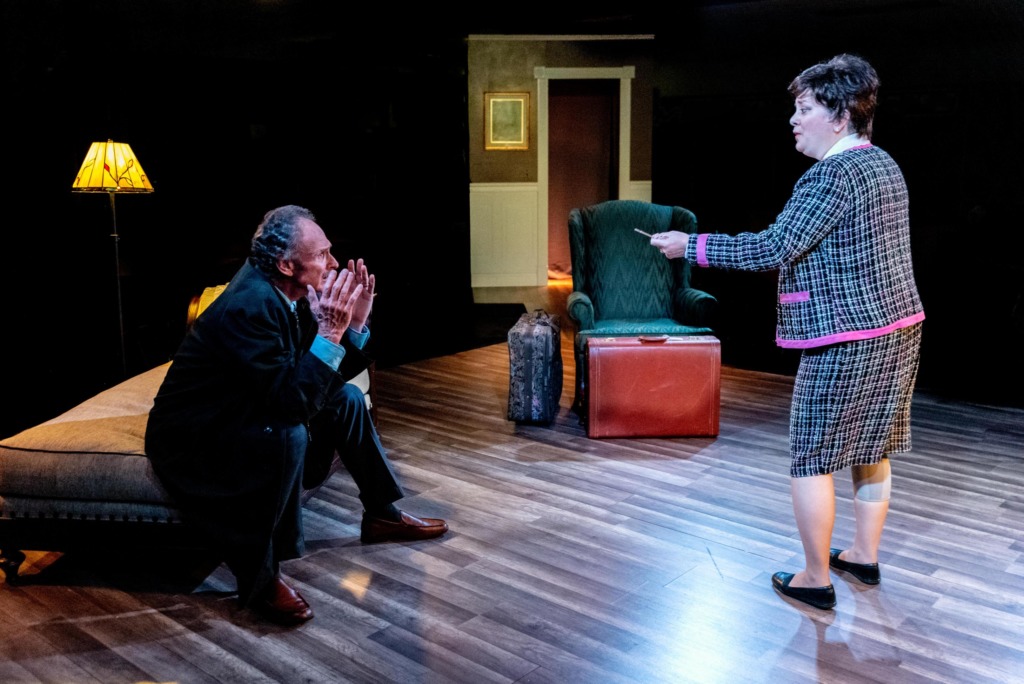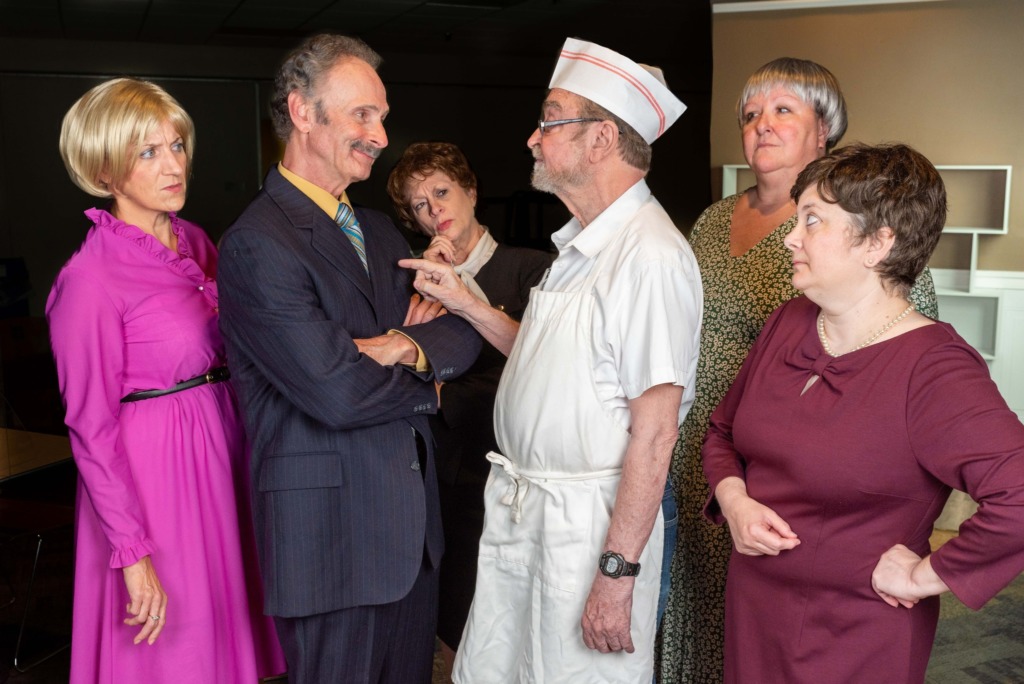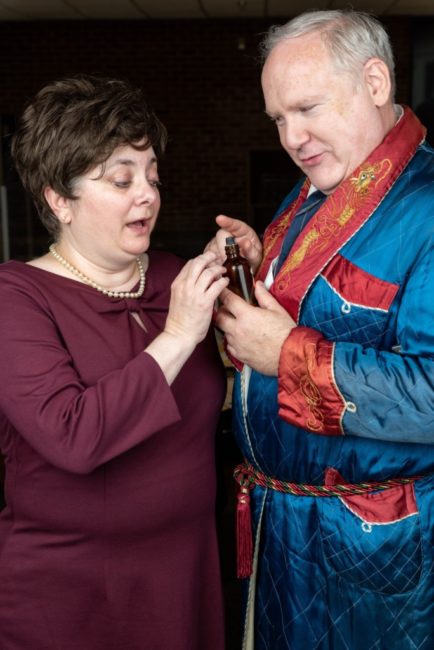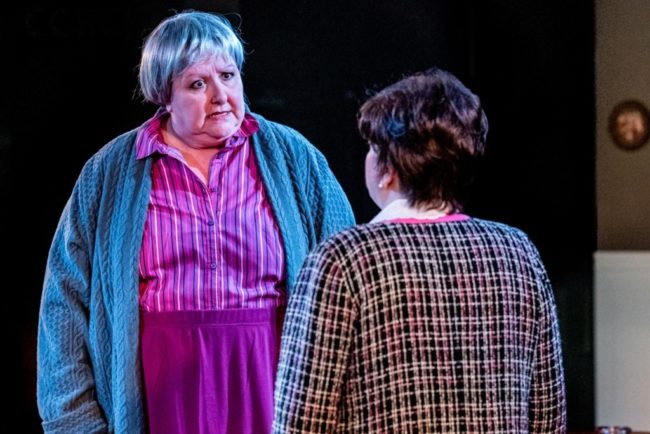Are you a night owl? A moon people? Do you stay awake at night seeing bodies that nobody else sees in large, green, wingback chairs in an abandoned apartment slum across the alleyway from your own apartment? Perhaps you are secretly a part of— *gasp*— Night Watch now appearing in the upstairs cabaret performance space of Cockpit in Court. Directed by Linda Chambers, this suspenseful thriller will keep you guessing right up until the end.

Dropping into a well-heeled luxury apartment somewhere in New York City circa 1972, the show’s scenic and lighting designer G. Maurice “Mo” Conn III settles the audience in with his upscale décor and posh interior design work. Calibrating a stage to play in the unique ‘in-the-square’ sectional with diagonal-x cross paths is no simple feat, but Conn’s seasoned skills create a lavish layout that convinces the audience we’ve traveled a gentle 50 years back in time. He even overcomes the challenges of not really having walls in the center play space and hangs three large paintings (which are an integral, albeit peripheral, feature and factor of the play) from the ceiling so that they hang free-form with the illusion of hanging on the wall. Conn’s lighting is impressive, the constant deep blues and queer greens to indicate odd hours of the night and the way he sets the lighting to work in the ‘window corner’ where all of the ‘events’ take place is impressive. Adding to the show’s overall impressive aesthetic, Costume Designer Eva Grove has put a gentle point on the decade’s style choices, particularly when it comes to the posh and pressed skirt suits seen on three of the four female characters in the performance. Where Grove really knocks the show’s sartorial selection out of the park are with the eccentric catalogue of looks featured on the Curtis Appleby character. The character is a peculiar sort and Grove really finds fabulous fashion accents to amp up the level of strangeness to this off-beat character.
It’s not that the show’s pacing is lacking; ultimately the show runs a little over two hours including the intermission, but there are moments when the dialogue delivery and unfurling of events feels as if it should be happening with more urgency. There is also somewhat of a mismatch in cadence and delivery; about half of the cast— including the minor characters of Officer Vanelli and Sam Hoke Deli Man— really feel as if they’re existing in New York circa 1972, with that slight feel of the city in their textual delivery and hints of that just-faded Trans-Atlantic patois that didn’t fade away from popular culture until the early 70’s. But the other half, particularly with Elaine and Blanche, sound as if they’re in a more modernized production. The playwright’s style is very specific to the era for which it was written and a more modern cadence, patois, and overall delivery feels jarring at times.

The supporting cast is surprisingly in the moment and thriving in the era of the show. Rodney Bonds, playing the one-blink character of Sam Hoke (as in blink and you’ll miss him) is the epitome of an irritated, aggravated, crotchety, and curmudgeonly old deli owner, complete with old-fashioned apron and paper deli hat. You get maybe two minutes of Bonds’ character on stage but he is lively, somewhat obstreperous, and tongue-in-cheek, switching on the charm to attempt to sell very reasonably priced roast beef. Playing the somewhat stalwart Officer Vanelli, Leonard Gilbert masters the tone and patois of a New York City beat cop; his one liners are pithy but potent, particularly when making casual observations about the art hanging in the Wheeler apartment. There’s just something about the way that Gilbert carries himself that makes you believe he’s a real ‘Big Apple Beat Cop’ from the early 70’s.
Lt. Walker (Joey Hellman) is of a similar authenticity when it comes to believing the character. Hellman is a bit bombastic and a bit loud at times, but it is ultimately supported by his character’s frustrations and overall exasperation at having to deal with Elaine Wheeler and all of her ‘hysterics.’ Hellman ultimately helps spearhead the underrated comedic ending of this production perhaps without even realizing it in his gruff and authoritative ways. And while Hellman is busy holding the ‘too-loud’ title, Eva Grove takes up the ‘soft-spoken’ badge of honor, though you never struggle to physically hear her. Playing the becalmed Dr. Tracey Lake, Grove is almost nurturing in that uneasy sense that puts you teeth on edge when it comes to dealing with psychiatrists.

Infinitely interesting in his curious appearance— both what he’s wearing and the way in which, like a bad penny, he just keeps turning up— Curtis Appleby (Thomas C. Hessenauer) is the most intrinsically intriguing character in the script. A bit like a Miss Marple type, only with more eccentricity and flare, and somewhat less of the deductive reasoning, the Curtis Appleby character comes roaring to vibrant, albeit curiously odd, life in the capable hands of Hessenauer. There’s something meandering about the accent Hessenauer lends to the character and it feels awkwardly intentional, almost as if he’s trying to hide something or be someone he’s not, and this adds enigmatic layers to the character, making him a very colorful person of interest.
Stealing the comedic thunder of the play, Liz Boyer Hunnicutt as the formidable house servant Helga is ripping the audience to stitches and often without saying anything at all. It’s Hunnicutt’s cutting looks— particularly the withering glances (you know, the ones that if looks could kill…) she keeps glaring in Blanche’s general direction. With a good German accent, which is just slightly overexaggerated but again works well for this character choice, Hunnicutt really adds a lighthearted and comedic element to this production, which as it turns out, is extremely well-received by the audience.

In a dizzying whirlwind of confusions, lies, hysterics, and all-sorts, there’s John Wheeler (Thom Peters), wife Elaine Wheeler (Regina Rose), and Blanche (Jennifer Skarzinski), Elaine’s best friend who has come to stay with The Wheelers for a while. Peters’ performance is the most in-sync with the time period, and his generalized delivery actually sounds a bit like Alan Alda, if Alan Alda were trapped with a wife prone to histrionics and her best friend who constantly seems to be setting off these episodes. The chemistry between Peters’ John and Rose’s Elaine is a burbling mess of impatience and exasperation which has long overshadowed the tenderness of their romance, though this is quite convincing as far as the plot is concerned. There are little moments— like when they start reminiscing over a particular memory from early in their marriage— where you can sense the genuine love that the two character’s share. Rose, as the inconsolable and perhaps even unstable, Elaine Wheeler, does a fine job at laying down her hysterical fits of breaking down into tears and shrieks. These moments fit 100% into the 1972 wrapper the play has provided, though her generalized speaking and overall character interactions lend themselves much more to a modern time period.
It’s ultimately a shock— the twisted ending will thrill you! Be sure to catch Night Watch this summer in the upstairs cabaret space of Cockpit in Court.
Running Time: 2 hours and 10 minutes with one intermission
Night Watch plays through June 26, 2022 Cockpit in Court in the upstairs Cabaret Space of The Robert and Eleanor Romadka College Center at the Community College of Baltimore County Essex Campus— 7201 Rossville Boulevard, Essex MD. For tickets call the box office at (443) 840-2787 or purchase them online.
